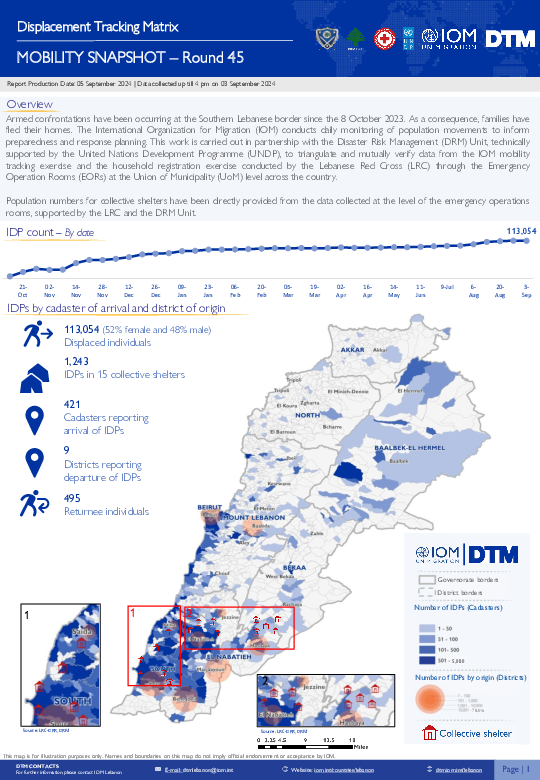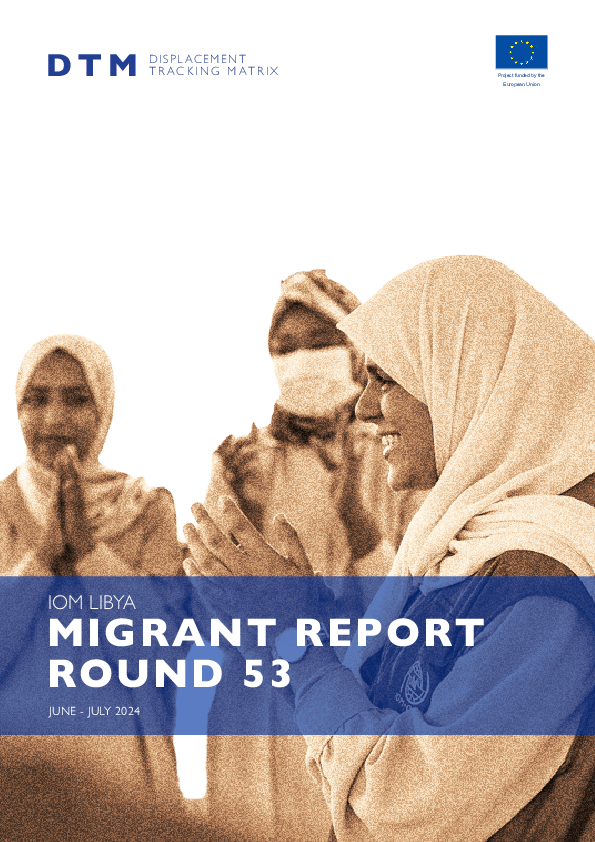-
Countries
-
Data and Analysis
-
Special Focus
-
Crisis Responses
Baseline Assessment
Contact
dtmlebanon@iom.int
Location
Lebanon
Activity
- Mobility Tracking
- Baseline Assessment
Period Covered
Oct 10 2023 -Sep 03 2024
Since October 8 there has been an increase in cross-border incidents between Israel and Lebanon, resulting in the displacement of people both within the South and elsewhere within the country. Since October 10, the Displacement Tracking Matrix (DTM) has been conducting the daily monitoring of population movements. The objective of the exercise is to inform preparedness and response planning.
Aggregated data is available through the DTM API: https://dtm.iom.int/data-and-analysis/dtm-api
A more detailed version of this dataset is available, to get access kindly click on the 'Request Access' button
Population Groups
IDPs
Returnee (Previously Internally Displaced)
Survey Methodology
Unit of Analysis Or Observation
Admin Area 2
Admin Area 3
Household
Individual
Type of Survey or Assessment
Keywords
Geographical Scope Full Coverage
Administrative boundaries with available data
The current dataset covers the following administrative boundaries
Contact
DTMSudan@iom.int
Location
Sudan
Activity
- Mobility Tracking
- Baseline Assessment
Period Covered
Jul 01 2024 -Aug 27 2024
- DTM Sudan estimates that 10,834,382 individuals (2,186,855 households) are currently displaced in Sudan, as of 27 August 2024.
- An estimated 8,066,827 individuals were displaced since 15 April 2023.
- An estimated 2,344,904 individuals crossed borders into neighbouring countries since 15 April 2023.
A more detailed version of this dataset is available, to get access kindly click on the 'Request Access' button
Population Groups
IDPs
Survey Methodology
Unit of Analysis Or Observation
Admin Area 2
Household
Individual
Type of Survey or Assessment
Key Informant
Keywords
Geographical Scope Full Coverage
Administrative boundaries with available data
The current dataset covers the following administrative boundaries

Contact
dtmlebanon@iom.int
Language
English
Location
Lebanon
Period Covered
Oct 10 2023
Sep 10 2024
Activity
- Mobility Tracking
- Baseline Assessment
Since October 8 there has been an increase in cross-border incidents between Israel and Lebanon, resulting in the displacement of people both within the South and elsewhere within the country. Since October 10, the Displacement Tracking Matrix (DTM) has been conducting the daily monitoring of population movements. The objective of the exercise is to inform preparedness and response planning.

Contact
DTM Somalia, IOMSomaliaDTM@iom.int
Language
English
Location
Somalia
Period Covered
Aug 31 2024
Sep 04 2024
Activity
- Mobility Tracking
- Baseline Assessment
This latest round of Emergency Trends Tracking was initiated in April 2024 to monitor displacements movements during the Gu rainy season. Districts covered in this round include Afgooye, Afmadow, Baardheere, Baidoa, Balcad, Belet Weyne, Belet Xaawo, Cabudwaaq, Dayniile, Dhuusamarreeb, Doolow, Gaalkacyo, Garoowe, Hodan, Jamaame, Jowhar, Kahda, Kismaayo, and Luuq. ETT is a crisis-based tool that tracks sudden displacement triggered by specific events or emerging crises.
The objective of ETT is to help prioritize humanitarian response and to enable partners to deliver rapid assistance. Based on previous shock induced displacement patterns, the humanitarian community expects that people will continue to move toward urban areas in search of humanitarian services. Consequently, the ETT coverage focuses on the main urban centers and surrounding villages for each assessed district. The data is collected through Key Informant Interviews (KIIs) at the location level, from Sunday to Wednesday every week. It includes information on new arrivals, numbers and demographic of IDPs, reasons for displacement, intentions, humanitarian assistance and priority needs among others.
To facilitate the joint analysis of the CCCM (Camp Coordination and Camp Management) Cluster’s New Arrivals Tracker (NAT) and ETT data, the assistance and needs indicators are identical in both tools.
Contact
iomastana@iom.int iomalmaty@iom.int
Location
Kazakhstan
Activity
- Mobility Tracking
- Baseline Assessment
Period Covered
Oct 10 2023 -Jan 22 2024
During the assessment, 2,303 key informants were interviewed. Based on the key informants' estimates, 639,799 international migrant workers were hosted in the assessed locations in Kazakhstan from 2020 to 2023. Concurrently, 41,574 internal migrants were hosted in the assessed locations, and 10,544 Kazakh nationals were reported to be residing abroad as international migrants. In addition, 6,005 return migrants have returned from abroad.
Population Groups
Migrants Present
Residents
Survey Methodology
Unit of Analysis Or Observation
Admin Area 2
Admin Area 3
Community
Type of Survey or Assessment
Key Informant
Keywords
Geographical Scope Partial Coverage
Administrative boundaries with available data
The current dataset covers the following administrative boundaries

Contact
dtmlebanon@iom.int
Language
English
Location
Lebanon
Period Covered
Oct 10 2023
Sep 03 2024
Activity
- Mobility Tracking
- Baseline Assessment
Since October 8 there has been an increase in cross-border incidents between Israel and Lebanon, resulting in the displacement of people both within the South and elsewhere within the country. Since October 10, the Displacement Tracking Matrix (DTM) has been conducting the daily monitoring of population movements. The objective of the exercise is to inform preparedness and response planning.
Contact
DTM Mozambique, DTMMozambique@iom.int
Location
Mozambique
Activity
- Mobility Tracking
- Baseline Assessment
Period Covered
May 15 2024 -Jun 15 2024
Population Groups
Survey Methodology
Unit of Analysis Or Observation
Type of Survey or Assessment
Keywords
Geographical Scope
Administrative boundaries with available data
The current dataset covers the following administrative boundaries
Contact
DTM Mozambique, DTMMozambique@iom.int
Location
Mozambique
Activity
- Mobility Tracking
- Baseline Assessment
Period Covered
May 15 2024 -Jun 15 2024
Population Groups
Survey Methodology
Unit of Analysis Or Observation
Type of Survey or Assessment
Keywords
Geographical Scope
Administrative boundaries with available data
The current dataset covers the following administrative boundaries
Contact
dtmlibya@iom.int
Location
Libya
Activity
- Mobility Tracking
- Baseline Assessment
Period Covered
Jun 01 2024 -Jul 31 2024
Libya Migrants baseline assessment and flow monitoring Round 53 Dataset
Population Groups
Migrants Present
Survey Methodology
Unit of Analysis Or Observation
Admin Area 2
Admin Area 3
Admin Area 4
Individual
Type of Survey or Assessment
Key Informant
Keywords
Geographical Scope Full Coverage
Administrative boundaries with available data
The current dataset covers the following administrative boundaries

Contact
DTM Libya, DTMLibya@iom.int
Language
English
Location
Libya
Period Covered
Jun 01 2024
Jul 31 2024
Activity
- Mobility Tracking
- Baseline Assessment
IOM Libya’s Displacement Tracking Matrix (DTM) programme identified a total of 761,322 migrants from 44 nationalities in the 100 Libyan municipalities during round 53 of data collection (June - July 2024).
The number of migrants in Libya has continued to increase slightly (+5%) compared to the previous round of data collection in line with a trend that started in December 2023. The rise in the number of migrants in Libya can be at least partially linked to the continuous arrival of Sudanese migrants, particularly in Alkufra, because of the ongoing conflict in their country of origin. While the number of migrants identified by DTM Libya in July 2024 is the highest since DTM started collecting data in 2016 it remains lower than prior to the onset of conflict in 2011 when it was estimated to be around 2.5 million.
Pagination
- Previous page
- Page 10
- Next page
